
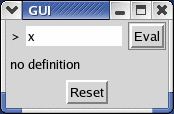
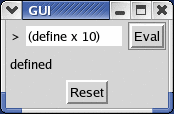
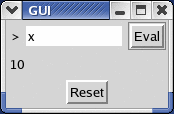

The teachpack adds the following primitive operations:
The read-from-string function uses the following data definitions:
;; An snl is either ;; - sym ;; - num ;; - list-of-snl ;; ;; A list-of-snl is either ;; - empty ;; - (cons snl list-of-snl)
See also the slides for October 22 for background on this assignment.
Implement add-definition, which takes a symbol and a number and records that the given symbol is "defined" to be the given number, but only if it has not been defined before. If the symbol has been defined before, the result is "already defined", and the definition is not changed. Otherwise, the definition is remembered and the result is "defined".
Implement get-value, which takes a symbol and returns either a number or false. The result is a number when the given symbol is defined, and the result number is the defined value of the symbol. If the symbol has not been defined, the result is false.
Implement clear-definitions, which takes no arguments and returns (void), but also forgets all previous definitions.
In all cases above, "defined" means "defined in your model of DrScheme". Evaluating (add-definition 'x 10) should not cause x in DrScheme's interactions window to produce 10, but it should cause (get-value 'x) to produce 10. Clearly, the functions add-definition, get-value, and clear-definitions share state.
Example:
(clear-definitions) "should be" (void) (add-definition 'x 10) "should be" "defined" (add-definition 'y 7) "should be" "defined" (get-value 'x) "should be" 10 (get-value 'y) "should be" 7 (get-value 'z) "should be" false (add-definition 'x 11) "should be" "already defined" (get-value 'x) "should be" 10 (clear-definitions) "should be" (void) (get-value 'x) "should be" false (get-value 'y) "should be" false (get-value 'z) "should be" false
More data definitions:
;; A defn-snl is ;; (list 'define sym num) ;; ;; An expr-snl is ;; sym
Implement the following functions:
; is-defn? : snl -> bool ; Returns true if s is a defn-snl (define (is-defn? s) ...) is-expr? : snl -> bool ; Returns true if s is a expr-snl (define (is-expr? s) ...)
Implement the function execute which takes a snl and produces a string:
Example:
(clear-definitions) "should be" (void) (execute 'x) "should be" "no definition" (execute '(define x 12)) "should be" "defined" (execute 'x) "should be" "12" (execute '(x x x)) "should be" "bad input" (execute '(define x 10)) "should be" "already defined"
Create a GUI with the following controls:
Connect your GUI to your execute and clear-definitions functions. Use text-contents and read-from-string to convert the text in the input field into a snl.
At this point, you should have a roughly functioning DrScheme, as illustrated inthe following sequence:
 |
 |
 |
 |
| hit Reset |
 |
Implement set-definition, which takes a symbol and a number and changes the defined value of the given symbol to the given number, but only if the symbol was previously defined. The result should be "assigned" if a definition is changed, or "not defined" if the given symbol was not previously defined.
Example:
(clear-definitions) "should be" (void) (set-definition 'x 5) "should be" "not defined" (add-definition 'x 10) "should be" "defined" (get-value 'x) "should be" 10 (set-definition 'x 5) "should be" "assigned" (get-value 'x) "should be" 5
A new data definition:
;; An assign-snl is ;; (list 'set! sym num)
Implement the following function:
is-assign? : snl -> bool ; Returns true if s is an assign-snl (define (is-assign? s) ...)
Change execute by adding a new case:
At this point, your GUI will support assignment.
 |
 |
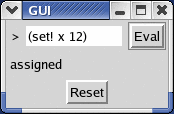 |
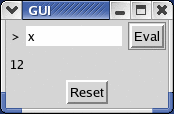 |
| Last update: Monday, October 27th, 2003mflatt@cs.utah.edu |